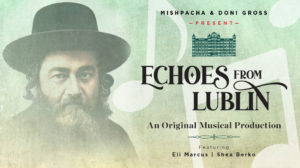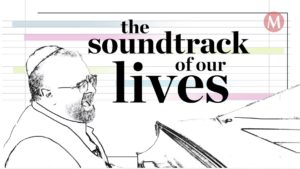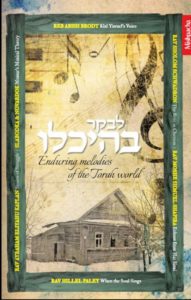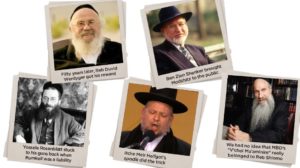A Message Cloaked in Melody
| January 4, 2012
T
here is a panoply of personalities at my doorstep. A jaded yeshivah bochur wary of the dating scene an anxious woman contemplating her upcoming Pesach cleaning chores a Sephardic schmaltz-herring eater from Holon and a baseball bat–toting member of the once-legendary East Side Bums all crowd in. Close behind follow a wizened inventor of a marvelous machine the former owner of a coveted Joe DiMaggio baseball card and even a little neshamah’leh flying in together with his very own malach’l. A crazy hallucination? A mixed-up dream? Those of you who are already hearing strains of music know better. My multifaceted visitor is none other than Abie Rotenberg the man behind the music of Journeys D’veykus Aish HASC The Marvelous Midos Machine and more.
He comes bearing gifts — a handful of CDs and the much-coveted Journeys Songbook — and he’s also brought “protection”: longtime producer and close friend Mutty Grunberg of M&M Enterprises who in his other life travels the world as a mashgiach kashrus. Mutty has just returned from Tibet where he tells me he supervised the milking of yaks.
It’s a great way to get us going this morning — probably fodder for another article! I know I’ve wanted to talk with Abie Rotenberg ever since I first listened to his hypnotic music. How I have marveled time and again does he do it? How does this Los Angeles-born Toronto-based businessman use his spare time to create such a wide variety of songs spinning the words themes and tunes so enchantingly that the mind and soul cannot help but be stirred to inspiration and even change?
Abie’s sincere soft-spoken words shine a spotlight on the art of music-making the messages behind his songs and even the future of Jewish music. This is a rare concert low-key but powerful and much of it is performed backstage. We begin at the beginning with the essence of music and Abie is — well amazingly Abie. Thoughtful contemplative creative and totally refreshingly real.
Like a Spice
He sets the stage, like any self-respecting musical storyteller would, with a rich metaphor. “Music is like a spice,” Abie says. “Food is bland without seasoning, and life without music would be no different. Music magnifies our sadness and sense of loss when we sing about the Churban, just as it generates intense happiness and the urge to dance when joyously played at a simchah. You can enhance inspiration and emotion with music, and it’s such a wonderful vehicle for enriching our lives. If you’re singing about emunah to the tune of ‘Ani ma’amin,’ the impression it makes on your neshamah is greater, simply because of the music. Or when you sing a song that expresses love for the Ribono shel Olam, like ‘Avinu Malkeinu,’ or for Torah, like ‘Mah ahavti sorasecha,’ the love and feeling reach a completely different level.”
He aptly describes a niggun as “a pasuk cloaked in music,” highlighting how the essence of the words changes with the addition of a beautiful tune. “Would tefillah be the same if we just read the words? By giving words a flavor, it makes them more memorable. If you merely teach children the words ‘Torah tzivah lanu Moshe,’ it doesn’t really make an imprint on them. But teach them to sing the ‘Torah tzivah’ song and they’ll remember it forever.”
It’s easy to look at a seasoned songwriter and musician like Abie and think, “Yeah, he can do it — it’s second nature!” But apparently, it wasn’t always that way.
“Although I come from a musical family, I was absolutely not any kind of child prodigy,” he confides. “I never thought that music would become such a significant part of my life. I could carry a tune … not that much to write home about.”
However, as a young adult, hashgachah arranged for Abie to cross paths with some of the major personalities in Jewish music of that day. Eli Teitelbaum was a neighbor and mentor, and at Camp S’dei Chemed, where Eli gave him a job as a counselor back in 1970, he met Baruch Chait, Yisroel Lamm, Eli Kranzler, and other talented musicians who worked there.
“I think I was the only one there who couldn’t play an instrument!” Abie laughs. “So I felt a sort of kinas sofrim take over me, and I worked hard that summer to learn guitar and keyboard. When I returned to Yeshivas Chofetz Chaim after the summer, the mashgiach set me up to be a chavrusa with, of all people, Label Sharfman of the Rabbis’ Sons! It was Label’s encouragement and his endorsement of my compositions (after seder hours, of course) that led to the first D’veykus recording back in 1973.”
An Evolving Art
Songwriting is undoubtedly an art, and each craftsman approaches it from his own angle and muse. For many, the process is so intuitive that it’s hard to describe. For Abie Rotenberg, music-making is a variegated experience, and he is candid about the amount of effort it involves.
“Any composer will tell you that at times a melody can hit you like a brainstorm, and a song — even a good one — can be finished in minutes. From my own compositions, ‘Acheinu’ is a song that created itself really quickly. Other times, you have to work on the tune, molding and shaping it like a sculpture. The high part of ‘HaMalach’ went through at least three or four versions until I was happy.” He cracks a smile. “Regardless, writing original lyrics, as opposed to just creating a tune for existing words, is a much more strenuous undertaking. With rare exception, those kinds of songs come from 10 percent inspiration, 90 percent perspiration and — ignore the math — 100 percent siyata d’Shmaya!”
There have been some songs, however, that came to mind exceptionally smoothly. “Who Am I,” the ballad about special children written for one of HASC’s first concerts, was created in a burst of inspiration and deep emotion. Abie remembers how producer Sheya Mendlowitz sent him a video depicting life at Camp HASC, his very first glimpse of the organization.
“I first started watching this compelling and extremely moving video at 10 p.m. on a Motzaei Shabbos, and I had the entire song — words and music — completed by two in the morning,” says Abie. "'Memories,’ on the other hand, took over five years to write. I had the line about the numbers on the arm playing around in my head for a long time, but how do you write a song about the Holocaust? How do you write about the unthinkable? Although it was difficult, I very much wanted to express this theme, and after many years, I finally was happy with the result.”
What will become of all the memories
Are they to scatter with the dust in the breeze
Yet one thought gives me comfort
It’s all that I have left
I know that G-d in heaven
Won’t forget
He gives more insight into the bricks and mortar of creating Jewish music by reflecting on the importance of properly pairing the words with the tunes.
“In response to those who claimed that modern Hebrew would ensure the survival of the Jewish People, Gershon Winkler wrote, ‘Bilaam’s donkey also spoke Hebrew!’ Lashon hakodesh doesn’t necessarily infuse something with spirituality and just because someone sings words from the siddur or Tanach, those words don’t automatically make the tune spiritual or kosher. And nothing is more important for a song with words than for the melody to facilitate the meaning of those words, or what is called peirush hamilos.” He shrugs. “I’m really not a fanatic about this. I recognize that music evolves and changes. The music of a hundred years ago is very different from today’s music. My children enjoy songs that I may not be particularly fond of and much of my music and the music I grew up listening to was foreign to my father’s ear.”
He nimbly picks up his opening theme. “We talked about spices. A person growing up in New York will have a different palate than does someone growing up in Europe or China or India. Today, our young people are attuned to certain rhythms, and if our music doesn’t have some connection to those rhythms then they won’t relate to it.
“Music has never been and never will be stagnant. I may not like or understand a certain composer’s interpretation, but he may have a different background in music. He may find inspiration in a contemporary rhythm and to him, the words are perfectly in sync with the tune he’s written. So who am I to say he’s wrong? I guess what I mean is — and I know I sound like a lawyer now — the most important thing is intent. If someone knowingly squeezes words of kedushah into a song simply because they fit, that’s a travesty. If the songwriter sincerely feels the words are enhanced and explained by his melody, then it is a legitimate form of expression.”
Yes, we’ve got the music
Songs both new and old
There’s nothing like a niggun
It’s music for your soul
But one thing we must keep in mind
A Jewish song of any kind
Is only precious if and when
It brings us closer to Hashem
Theme Song
Arranger Yisroel Lamm tells the story of a chassidic rebbe who was walking down the street when he heard a song being played exuberantly from a local pub.
“That song is full of simchah!” the rebbe remarked, whereupon he instructed his gabbai to go inside and find out the background to the song. The gabbai returned with a full report: the joyous song was a result of its non-Jewish composer having just won a court case against his Jewish opponent.
“That’s real simchah!” the rebbe enthused. “I’m going to take this niggun and be mekadesh it!”
It’s a great story, and a thought-provoking message, but I’m curious about the context. When Journeys first appeared on the music landscape, it was a new kid on the block. Fresh, fun, and a bit radical, it was a new product for the mainstream Jewish world, which had never before experienced Jewish-themed music sung to English words. Was it shocking? Was there a backlash?
“I really was not the new kid on the block,” Abie corrects the record. “The music of Megama, the Moshe Yess and Shalom Levine duo, came out a few years before Journeys. They were baalei teshuvah whose songs were all in English. I marveled at what they had done and I am indebted to them to this day, because their albums inspired me to try my hand at this genre. True, my background was different, coming from mainstream Jewish music, but I never doubted that there was room for an all-English album. There are hundreds of wonderful Yiddish songs reflecting Jewish life in Europe. The contemporary American experience is now growing long in the tooth as well. It’s inevitable that we chronicle it in song, in the language most spoken by all of us and offering a window into frum Jewish life.”
Journeys introduced the concept of themes. Each song showcased a particular theme and it’s obvious, as Abie discusses them, that the themes are the primary ingredient in all his work.
“For me, the heart of a song is its theme, and that’s the hardest component to come up with,” he explains. “Once you know what you want to say, finding a way to say it is not that difficult. Take a song like ‘The Shadchan,’ which features a rather cynical yeshivah bochur who’s burned out by his endless dating. There are a few themes in that song. First of all, never give up! Your bashert is out there somewhere. Second, after you’ve found your shidduch, help someone else find theirs! I was inspired to write the song by a friend who had dated for seven years. He told me he was always driving up the turnpike from Lakewood to New York, and that’s what got me started on that song.”
Is that how he gets the ideas for his songs? An anecdote? A story? An encounter? Abie gives the nod to all of the above. “Sometimes you hear a story or a joke and it triggers something that later becomes the kernel of a song.”
“So was an opulent chasunah the impetus for creating the ‘Wedding Song’?” I ask.
He smiles.
“Actually, that song developed after someone told me about a fancy wedding invitation he received that was printed with embossed gold lettering on luxurious parchment paper. On the bottom of the invitation, the hosts ended off by asking the women to please dress in accordance with the laws of modesty.
“The person who told me about it was commenting on the dichotomy here, how it was self-contradictory. On one hand the baalei simchah were asking for tzniyus, on the other hand, they themselves were being showy and ostentatious. A garment’s length is not the only criteria for modesty; everything one does should be with tzniyus. So that became the punch line at the end of the song. We’ve got chopped liver piled up to the sky, but dress tzniyus, if you please. Once I had a way to end the song, the rest was easy — talk to a caterer to find out what people are ordering these days!”
No, no, your guests will not be bored when they see that smorgasbord
With chopped liver piled up to the sky
And the band that you bring in should have 16 violins
Each one in a white tuxedo and black tie.
The wine, I’m sure you know
Has to be a French Bordeaux
Brought in on a shining silver tray
And the flowers, don’t forget, should be Holland’s very best
Flown in on the Concorde that same day
So on the invitation write, in a way that’s real polite
That the women should dress tzniyus, if you please,
‘Cause we’re dealing with a crowd that is also very proud
Of how it keeps the laws of modesty
Subtlety Speaks
I wonder whether Abie needs to worry about the messages he brings to the fore, or if he feels a need to couch them in certain terms so as not to offend listeners, especially because his musical themes can pack a punch. Abie gestures vaguely at the spread of CDs on the table.
“I usually try to be subtle with the message. I think if people experience a sense of discovery in the music and the message, it’s more exciting and meaningful for them. My rosh yeshivah, Rav Henoch Leibowitz ztz”l, used to question, ‘What? I’m going to spoon-feed you?’
“Often people will ask me for the meaning of a particular song. I like to turn it around and ask them, ‘What do you think?’ and usually their answers are spot on. ‘Joe DiMaggio’s Card,’ for example, has several themes. It’s about nostalgia, friendship, loyalty, the changing mores and spiritual growth of Yiddishkeit in America and how a baseball-playing youngster can become a gadol b’Yisrael. Whether all or part, as long as the song is meaningful in some way to the listener, provoking thought and hopefully offering inspiration, then I’ve succeeded.”
I ask him to relate the origins of “Sfashkenaz,” that wonderfully original creation, in which Sephardic and Ashkenazic music are knitted together with an important message on Jewish unity.
“It sort of dawned on me one day that some of the zmiros we sing on Shabbos are interchangeable as Sephardic or Ashkenazic. With a Sephardic hora-type beat, the same tunes sound like they originated in North Africa, but with an oom-pah beat, they could have come straight from the shtetl. Okay, so what? Well, one day a light bulb switched on! If I can take the same song and sing it both ways, then the message is that we’re all singing the same song! We all come from the same Avraham Avinu, we’re all Bnei Yisrael, we have the very same Torah. Sure, the way we express it, the minhagim we’ve adopted over the years, may differ, but if only we realized how similar we are, there would be more achdus in the world.”
My name is Kloinimus Kalman Fried
You can see I’m a chassidishe Yid
My house is near 16th and 53rd
Could there be a better place to live in the whole world?
But my life is different than it was before
Because a new neighbor just moved in next door
He looks and sounds different — a richteger Sephardi
So I’ll ignore him, and he’ll ignore me.
Now that we’re getting the inside scoop on the themes that inspired the songs, I grill Abie on some of my favorites. “Ride the Train”? That theme, he says, was pretty easy — both the image and sounds of a moving train conjure up a sense of movement from one place to another, which is precisely what going through life is all about. “Conversation in the Womb” is actually a mashal from the sefer Gesher HaChaim.
“While I was a bochur in yeshivah many years prior to writing that song, I first heard the mashal told over at a shivah house. The message was so powerful that it stayed with me,” he said.
Some of the sweetest music is born from the shards of pain. “‘Neshome’le’ was written after a student my wife and I had taught in Los Angeles tragically passed away, and we were deeply saddened. I wanted to somehow give some chizuk to the family, and I think we needed chizuk as well. The result was the song.” Why a neshamah and a malach? “I guess because it is such a universal and fundamental theme in our emunah. We come from above and then we go back. In between is the struggle of life. In the song, there is a musical interlude that is meant to symbolize a person’s life — going through all sorts of trials and tribulations, and then suddenly the malach, the angel, is back to take the person ‘home.’ I don’t know if people realize that, though.”
Strike a Spiritual Chord
While it’s hard to gauge what his listeners do and don’t understand from the complexities of his songs, it’s no secret that music holds a special power for inspiration and personal growth. But when I ask for examples of these profound changes he’s wrought in his audiences, Abie refuses to toot his own horn. His producer, Mutty, does it for him.
“We’ve received so many letters and e-mails over the years with testimonials from people who were impacted by Journeys,” Mutty Grunberg says proudly.
But Abie maintains that music is only part of the process. “A person who grows and improves in Yiddishkeit, or a child who improves his middos, has multiple sources of inspiration. Music can be, at best, one little brick on the wall. It’s certainly not going to support the whole structure, but it just might be enough to help someone get to the next level.”
He does allow that many mechanchim and individuals involved in outreach use his materials in some form or another, and that it is something he finds very fulfilling. No doubt, the powerful words of his songs have done much in bridging the gap between heart and mind, possibly even acting as the impetus for life-changing decisions. Rumor has it that one couple’s return to Torah-true Judaism was facilitated by hearing Abie’s sweetly sung ode to Yiddishkeit, “There’s No Place Like Home.” And chances are there are many more stories out there.
You had searched so long for the answers and the proof
And they said you’ll find it here, with promises of Truth
But the long white robes and the chanting in the streets
It left you cold; your soul still had to seek
What you’re looking for is right there at your door
Believe me when I tell you, friends, you couldn’t ask for more
What your heart has known is that there ain’t no place like home
So come on back. Oh, you’ll never be alone
“Music definitely has its place in the spiritual process,” Abie admits. “Not all growth will come from a speech, or a sefer, or a mussar shmuess. Maybe one person will be affected by a mussar sefer, but for another it takes a song to ‘strike a chord’ — excuse the pun! It may even be a niggun without words that inspires them. Music is really that powerful. It can unleash emotions like nothing else in the world.
“I’m not much into performing, it’s not my cup of tea,” he confesses, “but those who do it have a unique opportunity to inspire people when they’re onstage. I would love to hear those musicians connecting more with their audiences about the meaning of the words in their songs. They could tell a story, explain what Dovid HaMelech was hoping to teach with that particular phrase. In other words, use the opportunity onstage to send their audience home spiritually elevated. Don’t get me wrong, there is stirring, beautiful music being written and performed today by wonderful, sincere, and extremely talented people. But I think perhaps more can be done to make today’s concerts a more spiritually meaningful experience.”
Our foray into the broader world of Jewish singers and songs leads Abie onto a more sobering topic, one that threatens to impact the entire future of Jewish music and musicians.
“Music has become totally portable, it’s ethereal — it’s out in the wind. A CD is released and within hours, it’s all over the world with e-mail, computers, and online technology. If someone wants to just write and produce beautiful music today, there is no way for it to be financially viable. The only way to make a parnassah is by performing — whether at concerts or at simchahs — and that will lock out many talented individuals from being able to be part of the process.”
He relates a wonderful story told by Rabbi Baruch Chait, about a Yid traveling one Erev Shabbos who arrives at a shtetl right before sunset. With no other choice, he is forced to leave all his earthly possessions — two 50-ruble notes — in the local shul. How will he possibly safeguard them? Our Yid comes up with a brilliant plan. He goes over to the seforim shelf, takes out a Chumash, opens it up to the Aseres HaDibros, and places the money right under the words “Lo signov — Thou shalt not steal.” Then he closes the Chumash, puts it back on the shelf, and enjoys the rest of his Shabbos.
Come Motzaei Shabbos, the Yid rushes back to the Chumash and to his horror, the money is gone from its place! Frantically flipping through the rest of the pages, he suddenly comes across … one 50-ruble note, placed smack-dab under the words “V’ahavta lerei’acha kamocha — Love thy neighbor as thyself”!
We all laugh at the story, but the message isn’t so funny.
“No matter how you rationalize it, someone stole 50 rubles!” Abie sighs. “No one who produces and releases a CD today — which takes months of hard work and costs tens of thousands of dollars — is granting permission for those tracks to become hefker k’afra d’ara.”
The Machine Revisited
There’s a lull in the conversation, and it’s time to pounce on the latest Abie production — that nostalgic childhood mainstay, a wondrous mix of sci-fi, humor, and musical mussar shmuessen. Yes, after years and years, while its kugelator rusted away in the garage, the Marvelous Midos Machine has come back to life again, with the newly released Volume 4! Abie’s eyes twinkle and Mutty grins like a proud father.
“I never thought I would revisit the Marvelous Midos Machine,” Abie says, explaining the 20-plus-year gap in albums. “I thought we’d pretty much covered everything relating to middos with the first three tapes. But you see, now my own kids have grown up, and the eineklach have come into the picture, and they started doing this and that and kvetching about who knows what, and my children, who are now parents themselves, came to me with ideas. How about a song that will teach the kids to be mevater? What about getting them to be more patient? So new ideas and middos scenes came to mind — not to mention the fact that my grandchildren knew very well that their parents had received acting parts on the old tapes, and they wanted parts too! So Zeidy had to put together a whole new album for them!”
For those of you who can already hear that gurgling hum in the background while beloved Shnooky Shapiro (“Uh, Dr. Midos? Am I … beloved or, uh, am I just really … uh, aggravating?”) mans the controls, you needn’t worry. While the rest of the world has evolved since Marvelous Midos Machine left off in 1988, Dr. Midos has remained in a comfortable time warp. Volume 4 picks up where its predecessor left off, which means today’s technology-addicted kids will be treated to a step back in time to what life was like 30 years ago. As in, “Quick! Run out to your car phone!” and other such prehistoric references.
The main actors — Rabbi Shmuel Klein, Abie, Reb Moish Blaustein, and Shloimy Goldreich — have remained blessedly the same. Of course, there’s got to be some innovation; after all, Dr. Midos has always been on the cutting edge, inventing satellite technology when the world had never even heard of GPS! So Elchonon Schwartz, the well-known Oorah actor, lends his talents to MMM 4, executing no less than 10 parts — including President Ronald Reagan! And then there are the grandchildren …
Who spilled the milk on the kitchen floor?
Not me! Not me!
And who took a pen and wrote on the wall?
No, it was not me!
***
Like I’ve said to you before
Never take kids to a store
All you’re gonna hear is…
“We want more and more!”
For those of you who still get the goose bumps when you remember the evil Dr. Doomshtein, and his final, highly climactic teshuvah turnaround (“I still get calls every year from Nachum Segal to edit out Doomshtein’s lines from the middle of ‘The Teshuvah Song’ so he can play it on his radio show during Elul!”) — sadly, he is no longer with us. The beloved musician Moshe Yess, who was a founding partner and strong contributor to the entire Marvelous Midos Machine series, was niftar this past year, but his character, Dr. Doomshtein, will forever remain imprinted on our hearts and minds.
Raise your hand if you’re guilty of singing the occasional Marvelous Midos Machine song to your little ones! I know I definitely am! But I can’t help but wonder — politely, of course — are the tapes really effective in getting kids to change their middos?
Abie smiles good-naturedly and tells over this gem of an anecdote: “When the first demo of Marvelous Midos Machine was completed, Moshe Yess and I called in two boys to listen to it. We sat them down on a small couch, waiting to observe their reactions. Sure enough, they’re listening with eyes open wide and mouths agape. Dizzy’s up in outer space, Doomshtein’s cackling, and everything’s going great.
“About 40 minutes in, the two boys start fighting. ‘Move over! You’re sitting on my spot!’ ‘I am not! You move over!’ And all the while, in the background, there’s the sweet refrain playing, ‘Shalom is peace and shalom’s the way…’ So thankfully, we got an early dose of reality not to expect too much.”
Creating albums for young listeners is perhaps even trickier than satisfying their parents, and Abie is candid about the balance. “You want to push, but not too hard. You don’t want to make kids feel guilty if they do something wrong. You want them to enjoy the songs and be inspired, but not to feel knocked down.”
I
t’s getting late. There are songs to write, yaks to milk, multitudes of middos to mend. Abie’s final message is heartfelt. “I’m grateful to have had the wonderful opportunity to create music. It’s a gift. It’s also been a blessing that I’ve been able to motivate and educate others. It’s important for people to try to use their talent in whichever way they can, and I’d love to see more music, especially in English — songs that are thought-provoking and meaningful, but rooted in Torah values. Today, anyone with a computer and a keyboard can make music from their own home studio. It can be a very honorable and rewarding craft.”
He is almost done, but I press him for his absolute favorite song.
Abie grins.
“I hope I haven’t written it yet!” he quips. He leans back in his seat, the man who gave us the soul-searing “Mama Rochel” and the fantastically funny “Yeshivishe Reid,” and turns his voice wry. “But I always joke that my all-time favorite is ‘I’m A Hippopotamus’!”
(Originally featured in Mishpacha Issue 391)
Oops! We could not locate your form.







